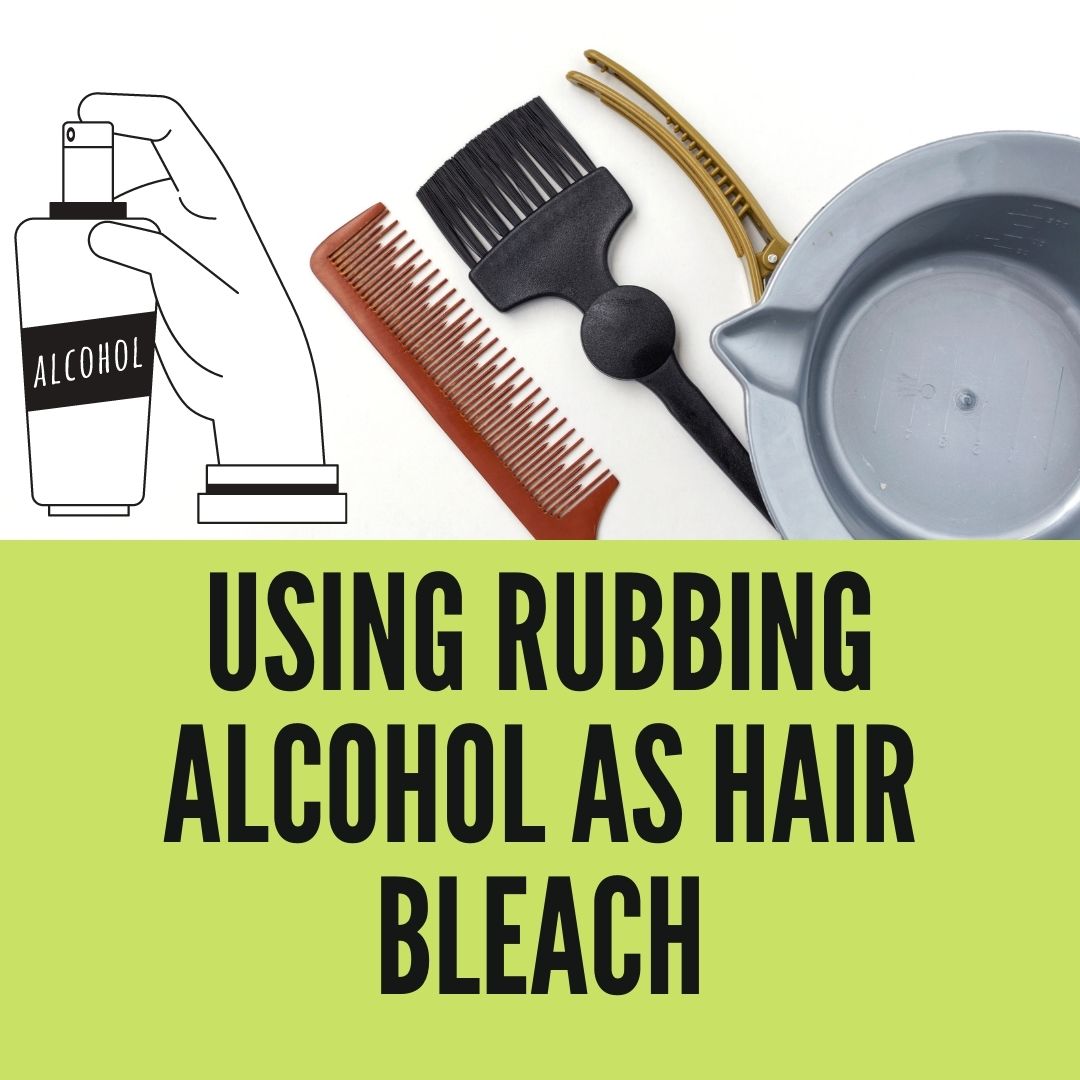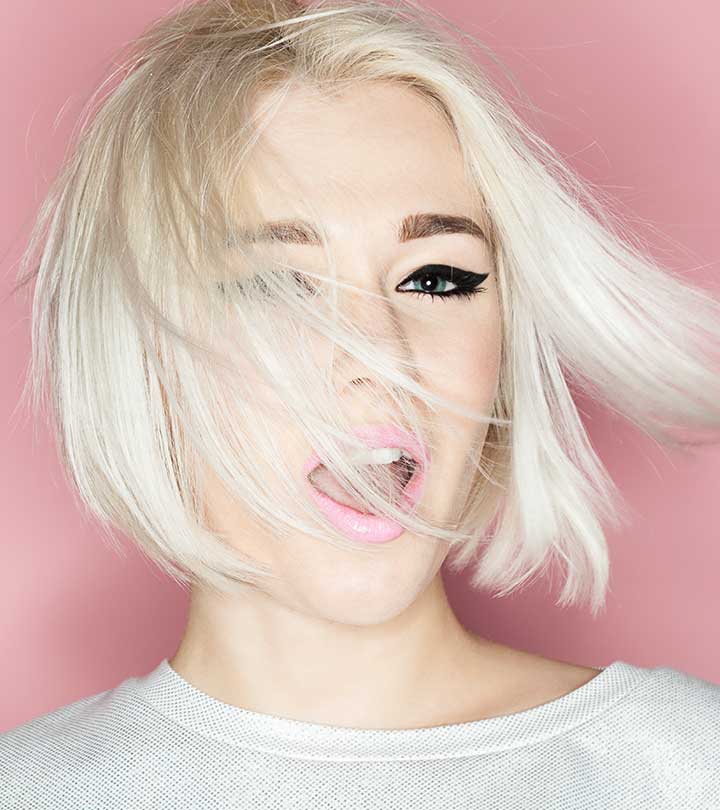
If you’ve ever woken up, looked in the mirror, and wished you saw something different, you’re not alone. From time to time, we all get the urge to change, and there’s nothing wrong with that! One of the simplest ways to change your entire appearance is to change the way your hair looks by cutting it, changing its color, or bleaching it!
So can you use rubbing alcohol to bleach your hair? Yes, One of the most common methods of at-home hair bleaching is to use rubbing alcohol. When applied directly to your hair, rubbing alcohol is able to effectively penetrate down to the core of your hair to remove your natural pigment. The end result will leave you with a bleached orange tone.

In today’s article, I’m going to go over how some people are using rubbing alcohol to bleach their hair and why it’s become such a trend.
I’ll also go over some of the dangers of this method and explain why you’re probably better off using other methods.
Bleaching Hair With Rubbing Alcohol
Let’s face it- not everybody has a bunch of money to go to a professional salon and pay hundreds of dollars to get their hair styled and color-changed, especially in this pandemic. This has led to a lot of people looking for more natural Do-It-Yourself methods of bleaching their hair.
But what does rubbing alcohol do to your hair? Rubbing alcohol is a chemical that removes protein from the hair cuticle, which leaves it dry and brittle. Rubbing Alcohol also strips away any natural oils or moisture in the hair shafts and scalp, leading to more frizziness, dullness, and flyaways.
So, first things first- how exactly does rubbing alcohol bleach hair?
Isopropyl rubbing alcohol and some of its alternatives (such as hydrogen peroxide) are able to bleach your hair through a process known as oxidation. For those of you who don’t remember basic chemistry, this is the process where one compound gives away its electrons to another. Basically, whatever is “oxidized” is destroyed.
For example, rust is a form of oxidation. When water molecules are repeatedly exposed to bare metal, the metal gives up its oxygen molecules and slowly decays. It doesn’t exactly sound like the healthiest for your hair, does it?
Anyways, back to the topic at hand- hair oxidation.
There is a wide range of different hair bleaching products on the market, and they all use the same chemical process. They use chemicals to penetrate your hair’s surface layer and then oxidize your hair’s natural pigmentation.
Although the desired “bleached” color is silver or white, your hair will turn out orange or a faded shade of brown most of the time.
Bleaching is almost never performed for the sake of bleaching. It’s usually just an in-between step that allows your hair to re-absorb whatever new pigment or hair dye you’re using to re-color your hair and change your style.
Rubbing alcohol is a powerful solvent solution that’s capable of dissolving a lot of things. You can use rubbing alcohol to remove acrylic paint and even car paint, so you can certainly dissolve hair dye and pigment with it.
It’s a relatively simple process.
All you need to do is wash your hair with shampoo to remove any dirt and oils and then spray it down with a strong solution of isopropyl rubbing alcohol.
Most people recommend using a 50% dilution, but some say that a 70% concentration works better. I’m always a proponent of starting small, though.
The longer you let the alcohol sit on your hair, the more it will bleach your hair. For example, if you just want to go a couple of shades lighter, you would let it sit for about 5 minutes.
On the other hand, if you wanted to go full orange and strip it of all colors, then you would want to soak your hair for about 10 minutes.
After it’s had time to soak, wash all of the alcohol out with cool water and give your hair some time to dry before applying your dye, conditioner, or moisturizer (depending on what you plan on doing with your hair).
- 99% Isopropyl alcohol is not intended for use on the skin
- Wash face, hands and any exposed skin thoroughly after handling product
- Do not eat, drink or smoke when using this product
- When using this product, wear protective gloves/protective clothing/eye protection/face protection Twelve 16-fluid ounce bottles
- An Amazon brand
- One 32 fluid ounce bottle of first aid antiseptic
- Packaging is transitioning and may vary from picture
- First aid to help prevent risk of infection from minor cuts, scrapes and burns
- Active ingredient: 70% isopropyl alcohol
Is It Dangerous To Bleach Your Hair With Rubbing Alcohol?
This is where I’m going to give you a fair warning and disclaimer, though:
Using rubbing alcohol to bleach your hair is NOT usually a good idea.
Let’s take a look at why.
If you do a bit of research on this common household product, you’ll find that it’s good for a lot of things. Rubbing alcohol can clean glass, be used to make disinfectant, and can even kill lice. However, it can also destroy your hair.
Normal hair bleaching is already incredibly taxing on your hair, and it’s designed to be used on hair. Even when it’s diluted, rubbing alcohol is a lot stronger than hair bleach. It’s also toxic when absorbed by your skin and scalp.
So, the best-case scenario is that it works and it’s able to remove your hair pigment and leave you with a clean slate so you can color your hair how you want.
If you have super-strong hair and a thick scalp, you might manage to escape with some dry scalp and dry hair. Thankfully these can usually be repaired by applying a lot of moisturizers.
However, there are hundreds of horror stories where people tried this method only to have their hair fall out days later. In addition to this, they’ll usually have a dry, red, and inflamed scalp as the alcohol will also pull all of the oils out of their skin.
Here are some other posts that might interest you:
- Different Kinds Of Rubbing Alcohol
- Are Isopropyl and Rubbing Alcohol the Same?
- Can I Use Rubbing Alcohol To Clean My Keyboard?
- How To Make Your Own Hand Sanitizer
- Can You Mail Rubbing Alcohol?
Rubbing Alcohol vs. Hair Bleach
When you use rubbing alcohol on your hair, you’re literally pouring poison on your hair. All this being said, this is definitely one of those “do it at your own risk” types of things. Regular hair bleach is almost as cheap as rubbing alcohol and can be purchased at most pharmacies or hair supply stores, so why not do that instead?
Although standard hair bleach certainly comes with its own limitations and warnings, at least it’s diluted enough so as not to cause lasting damage to your scalp or cause your hair to fall out. The worst thing that will happen with hair bleach is that you’ll have dry, frizzy hair.
The internet is full of great information, but it’s also full of some pretty awful advice as well. In my opinion, using isopropyl rubbing alcohol to bleach your hair is a bad idea and one that’s more likely to end in disappointment. Your hair is one feature that you don’t want to cheap out on!

My name is Logan, and I’m a 36-year-old dad who owns a small pressure-washing company in the suburbs of Atlanta, Georgia. My main goal with rubbing-alcohol.com is to show you how versatile isopropyl rubbing alcohol can be! I hope. You find it useful.


